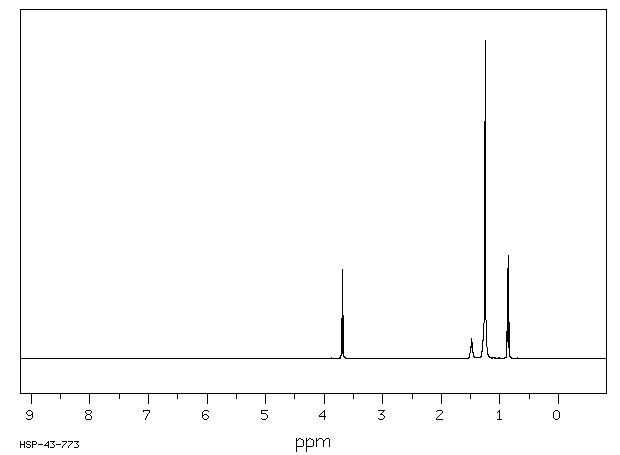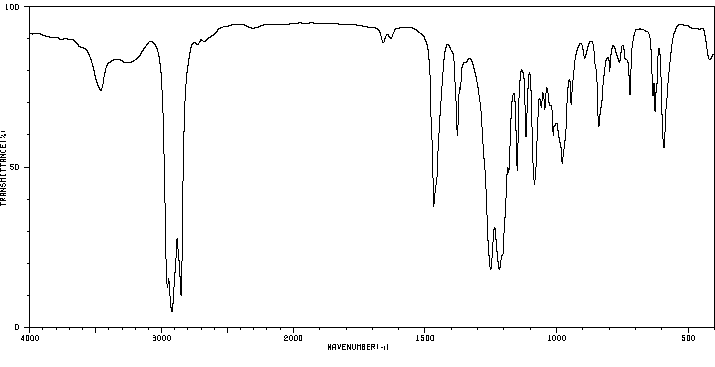Sulfuric acid, monodecyl ester, sodium salt | 142-87-0
中文名称
——
中文别名
——
英文名称
Sulfuric acid, monodecyl ester, sodium salt
英文别名
sodium decyl sulfate;sodium n-decyl sulfate;sodium;decyl sulfate
CAS
142-87-0
化学式
C10H21O4S*Na
mdl
——
分子量
260.33
InChiKey
XZTJQQLJJCXOLP-UHFFFAOYSA-M
BEILSTEIN
——
EINECS
——
-
物化性质
-
计算性质
-
ADMET
-
安全信息
-
SDS
-
制备方法与用途
-
上下游信息
-
文献信息
-
表征谱图
-
同类化合物
-
相关功能分类
-
相关结构分类
物化性质
-
熔点:192°C(lit.)
-
密度:1.209[at 20℃]
-
溶解度:易溶于水,难溶于有机溶剂。
-
最大波长(λmax):λ: 210 nm Amax: 0.05λ: 220 nm Amax: 0.04λ: 230 nm Amax: 0.03λ: 260 nm Amax: 0.02λ: 500 nm Amax: 0.02
-
LogP:1.72 at 25℃
-
物理描述:Liquid; WetSolid
-
稳定性/保质期:
在常温常压下,该物质是稳定的。
计算性质
-
辛醇/水分配系数(LogP):-0.39
-
重原子数:16
-
可旋转键数:10
-
环数:0.0
-
sp3杂化的碳原子比例:1.0
-
拓扑面积:74.8
-
氢给体数:0
-
氢受体数:4
安全信息
-
TSCA:Yes
-
危险品标志:Xn
-
安全说明:S26,S36/37/39
-
危险类别码:R38,R36,R22,R41,R37
-
WGK Germany:2
-
海关编码:3402110000
-
RTECS号:WS7625000
-
储存条件:密封于干燥阴凉处保存。
SDS
1.1 产品标识符
: Sodium dECyl sulfate
化学品俗名或商品名
1.2 鉴别的其他方法
DECyl sulfatesodium salt
1.3 有关的确定了的物质或混合物的用途和建议不适合的用途
仅供科研用途,不作为药物、家庭备用药或其它用途。
模块 2. 危险性概述
2.1 GHS分类
急性毒性, 经口 (类别4)
皮肤刺激 (类别2)
严重的眼损伤 (类别1)
2.2 GHS 标记要素,包括预防性的陈述
危害类型象形图
信号词 危险
危险申明
H302 吞咽有害。
H315 造成皮肤刺激。
H318 造成严重眼损伤。
警告申明
预防
P264 操作后彻底清洁皮肤。
P270 使用本产品时不要进食、饮水或吸烟。
P280 穿戴防护手套/ 眼保护罩/ 面部保护罩。
措施
P301 + P312 如果吞下去了: 如感觉不适,呼救解毒中心或看医生。
P302 + P352 如果在皮肤上: 用大量肥皂和水淋洗。
P305 + P351 + P338 如进入眼睛:用水小心清洗几分钟。如戴隐形眼镜并可方便地取出,取出
隐形眼镜。继续冲洗。
P310 立即呼救解毒中心或医生。
P321 具体治疗(见本标签上提供的急救指导)。
P330 漱口。
P332 + P313 如发生皮肤刺激:求医/ 就诊。
P362 脱掉沾染的衣服,清洗后方可重新使用。
处理
P501 将内容物/ 容器处理到得到批准的废物处理厂。
2.3 其它危害物 - 无
模块 3. 成分/组成信息
3.1 物 质
: DECyl sulfatesodium salt
别名
: C10H21NaO4S
分子式
: 260.33 g/mol
分子量
成分 浓度
Sodium dECyl sulphate
-
化学文摘编号(CAS No.) 142-87-0
EC-编号 205-568-5
模块 4. 急救措施
4.1 必要的急救措施描述
一般的建议
请教医生。 出示此安全技术说明书给到现场的医生看。
如果吸入
如果吸入,请将患者移到新鲜空气处。 如果停止了呼吸,给于人工呼吸。 请教医生。
在皮肤接触的情况下
用肥皂和大量的水冲洗。 请教医生。
在眼睛接触的情况下
用大量水彻底冲洗至少15分钟并请教医生。
如果误服
切勿给失去知觉者从嘴里喂食任何东西。 用水漱口。 请教医生。
4.2 最重要的症状和影响,急性的和滞后的
据我们所知,此化学,物理和毒性性质尚未经完整的研究。
4.3 及时的医疗处理和所需的特殊处理的说明和指示
无数据资料
模块 5. 消防措施
5.1 灭火介质
灭火方法及灭火剂
用水雾,耐醇泡沫,干粉或二氧化碳灭火。
5.2 源于此物质或混合物的特别的危害
碳氧化物, 硫氧化物, 钠的氧化物
5.3 救火人员的预防
如必要的话,戴自给式呼吸器去救火。
5.4 进一步的信息
无数据资料
模块 6. 泄露应急处理
6.1 人员的预防,防护设备和紧急处理程序
使用个人防护设备。 防止粉尘的生成。 防止吸入蒸汽、气雾或气体。 保证充分的通风。
将人员撤离到安全区域。 避免吸入粉尘。
6.2 环境预防措施
不要让产物进入下水道。
6.3 抑制和清除溢出物的方法和材料
收集、处理泄漏物,不要产生灰尘。 扫掉和铲掉。 存放在合适的封闭的处理容器内。
6.4 参考其他部分
丢弃处理请参阅第13节。
模块 7. 操作处置与储存
7.1 安全操作的注意事项
避免接触皮肤和眼睛。 防止粉尘和气溶胶生成。
在有粉尘生成的地方,提供合适的排风设备。一般性的防火保护措施。
7.2 安全储存的条件,包括任何不兼容性
贮存在阴凉处。 容器保持紧闭,储存在干燥通风处。
吸湿的
7.3 特定用途
无数据资料
模块 8. 接触控制/个体防护
8.1 控制参数
最高容许浓度
没有已知的国家规定的暴露极限。
8.2 暴露控制
适当的技术控制
根据工业卫生和安全使用规则来操作。 休息以前和工作结束时洗手。
人身保护设备
眼/面保护
面罩與安全眼鏡请使用经官方标准如NIOSH (美国) 或 EN 166(欧盟) 检测与批准的设备防护眼部。
皮肤保护
戴手套取 手套在使用前必须受检查。
请使用合适的方法脱除手套(不要接触手套外部表面),避免任何皮肤部位接触此产品.
使用后请将被污染过的手套根据相关法律法规和有效的实验室规章程序谨慎处理. 请清洗并吹干双手
所选择的保护手套必须符合EU的89/686/EEC规定和从它衍生出来的EN 376标准。
身体保护
全套防化学试剂工作服, 防护设备的类型必须根据特定工作场所中的危险物的浓度和含量来选择。
呼吸系统防护
如危险性评测显示需要使用空气净化的防毒面具,请使用全面罩式多功能微粒防毒面具N100型(US
)或P3型(EN
143)防毒面具筒作为工程控制的候补。如果防毒面具是保护的唯一方式,则使用全面罩式送风防毒
面具。 呼吸器使用经过测试并通过政府标准如NIOSH(US)或CEN(EU)的呼吸器和零件。
模块 9. 理化特性
9.1 基本的理化特性的信息
a) 外观与性状
形状: 薄片
颜色: 白色
b) 气味
无数据资料
c) 气味临界值
无数据资料
d) pH值
无数据资料
e) 熔点/凝固点
无数据资料
f) 起始沸点和沸程
无数据资料
g) 闪点
无数据资料
h) 蒸发速率
无数据资料
i) 可燃性(固体,气体)
无数据资料
j) 高的/低的燃烧性或爆炸性限度 无数据资料
k) 蒸气压
无数据资料
l) 相对蒸气密度
无数据资料
m) 相对密度
无数据资料
n) 水溶性
无数据资料
o) 辛醇/水分配系数的对数值
无数据资料
p) 自燃温度
无数据资料
q) 分解温度
无数据资料
r) 粘度
无数据资料
模块 10. 稳定性和反应活性
10.1 反应性
无数据资料
10.2 化学稳定性
无数据资料
10.3 危险反应的可能性
无数据资料
10.4 避免接触的条件
无数据资料
10.5 不兼容的材料
强氧化剂, 酸
10.6 危险的分解产物
其它分解产物 - 无数据资料
模块 11. 毒理学资料
11.1 毒理学影响的信息
急性毒性
半致死剂量(LD50) 经口 - 大鼠 - 1,950 mg/kg
备注: 行为的:嗜睡(全面活力抑制)。 消化系统失调 腹泻
皮肤腐蚀/刺激
无数据资料
严重眼损伤 / 眼刺激
无数据资料
呼吸道或皮肤过敏
无数据资料
生殖细胞诱变
无数据资料
致癌性
IARC:
此产品中没有大于或等于 0。1%含量的组分被 IARC鉴别为可能的或肯定的人类致癌物。
生殖毒性
无数据资料
特异性靶器官系统毒性(一次接触)
无数据资料
特异性靶器官系统毒性(反复接触)
无数据资料
吸入危险
无数据资料
潜在的健康影响
吸入 吸入可能有害。 引起呼吸道刺激。
摄入 误吞对人体有害。
皮肤 如果通过皮肤吸收可能是有害的。 造成皮肤刺激。
眼睛 引起眼睛烧伤。
接触后的征兆和症状
据我们所知,此化学,物理和毒性性质尚未经完整的研究。
附加说明
化学物质毒性作用登记: WS7625000
模块 12. 生态学资料
12.1 毒性
无数据资料
12.2 持久存留性和降解性
无数据资料
12.3 生物积累的潜在可能性
无数据资料
12.4 土壤中的迁移
无数据资料
12.5 PBT 和 vPvB的结果评价
无数据资料
12.6 其它不利的影响
无数据资料
模块 13. 废弃处置
13.1 废物处理方法
产品
将剩余的和未回收的溶液交给处理公司。 联系专业的拥有废弃物处理执照的机构来处理此物质。
与易燃溶剂相溶或者相混合,在备有燃烧后处理和洗刷作用的化学焚化炉中燃烧
污染了的包装物
作为未用过的产品弃置。
模块 14. 运输信息
14.1 UN编号
欧洲陆运危规: - 国际海运危规: - 国际空运危规: -
14.2 联合国(UN)规定的名称
欧洲陆运危规: 无危险货物
国际海运危规: 无危险货物
国际空运危规: 无危险货物
14.3 运输危险类别
欧洲陆运危规: - 国际海运危规: - 国际空运危规: -
14.4 包裹组
欧洲陆运危规: - 国际海运危规: - 国际空运危规: -
14.5 环境危险
欧洲陆运危规: 否 国际海运危规 海运污染物: 否 国际空运危规: 否
14.6 对使用者的特别预防
无数据资料
模块 15 - 法规信息
N/A
模块16 - 其他信息
N/A
: Sodium dECyl sulfate
化学品俗名或商品名
1.2 鉴别的其他方法
DECyl sulfatesodium salt
1.3 有关的确定了的物质或混合物的用途和建议不适合的用途
仅供科研用途,不作为药物、家庭备用药或其它用途。
模块 2. 危险性概述
2.1 GHS分类
急性毒性, 经口 (类别4)
皮肤刺激 (类别2)
严重的眼损伤 (类别1)
2.2 GHS 标记要素,包括预防性的陈述
危害类型象形图
信号词 危险
危险申明
H302 吞咽有害。
H315 造成皮肤刺激。
H318 造成严重眼损伤。
警告申明
预防
P264 操作后彻底清洁皮肤。
P270 使用本产品时不要进食、饮水或吸烟。
P280 穿戴防护手套/ 眼保护罩/ 面部保护罩。
措施
P301 + P312 如果吞下去了: 如感觉不适,呼救解毒中心或看医生。
P302 + P352 如果在皮肤上: 用大量肥皂和水淋洗。
P305 + P351 + P338 如进入眼睛:用水小心清洗几分钟。如戴隐形眼镜并可方便地取出,取出
隐形眼镜。继续冲洗。
P310 立即呼救解毒中心或医生。
P321 具体治疗(见本标签上提供的急救指导)。
P330 漱口。
P332 + P313 如发生皮肤刺激:求医/ 就诊。
P362 脱掉沾染的衣服,清洗后方可重新使用。
处理
P501 将内容物/ 容器处理到得到批准的废物处理厂。
2.3 其它危害物 - 无
模块 3. 成分/组成信息
3.1 物 质
: DECyl sulfatesodium salt
别名
: C10H21NaO4S
分子式
: 260.33 g/mol
分子量
成分 浓度
Sodium dECyl sulphate
-
化学文摘编号(CAS No.) 142-87-0
EC-编号 205-568-5
模块 4. 急救措施
4.1 必要的急救措施描述
一般的建议
请教医生。 出示此安全技术说明书给到现场的医生看。
如果吸入
如果吸入,请将患者移到新鲜空气处。 如果停止了呼吸,给于人工呼吸。 请教医生。
在皮肤接触的情况下
用肥皂和大量的水冲洗。 请教医生。
在眼睛接触的情况下
用大量水彻底冲洗至少15分钟并请教医生。
如果误服
切勿给失去知觉者从嘴里喂食任何东西。 用水漱口。 请教医生。
4.2 最重要的症状和影响,急性的和滞后的
据我们所知,此化学,物理和毒性性质尚未经完整的研究。
4.3 及时的医疗处理和所需的特殊处理的说明和指示
无数据资料
模块 5. 消防措施
5.1 灭火介质
灭火方法及灭火剂
用水雾,耐醇泡沫,干粉或二氧化碳灭火。
5.2 源于此物质或混合物的特别的危害
碳氧化物, 硫氧化物, 钠的氧化物
5.3 救火人员的预防
如必要的话,戴自给式呼吸器去救火。
5.4 进一步的信息
无数据资料
模块 6. 泄露应急处理
6.1 人员的预防,防护设备和紧急处理程序
使用个人防护设备。 防止粉尘的生成。 防止吸入蒸汽、气雾或气体。 保证充分的通风。
将人员撤离到安全区域。 避免吸入粉尘。
6.2 环境预防措施
不要让产物进入下水道。
6.3 抑制和清除溢出物的方法和材料
收集、处理泄漏物,不要产生灰尘。 扫掉和铲掉。 存放在合适的封闭的处理容器内。
6.4 参考其他部分
丢弃处理请参阅第13节。
模块 7. 操作处置与储存
7.1 安全操作的注意事项
避免接触皮肤和眼睛。 防止粉尘和气溶胶生成。
在有粉尘生成的地方,提供合适的排风设备。一般性的防火保护措施。
7.2 安全储存的条件,包括任何不兼容性
贮存在阴凉处。 容器保持紧闭,储存在干燥通风处。
吸湿的
7.3 特定用途
无数据资料
模块 8. 接触控制/个体防护
8.1 控制参数
最高容许浓度
没有已知的国家规定的暴露极限。
8.2 暴露控制
适当的技术控制
根据工业卫生和安全使用规则来操作。 休息以前和工作结束时洗手。
人身保护设备
眼/面保护
面罩與安全眼鏡请使用经官方标准如NIOSH (美国) 或 EN 166(欧盟) 检测与批准的设备防护眼部。
皮肤保护
戴手套取 手套在使用前必须受检查。
请使用合适的方法脱除手套(不要接触手套外部表面),避免任何皮肤部位接触此产品.
使用后请将被污染过的手套根据相关法律法规和有效的实验室规章程序谨慎处理. 请清洗并吹干双手
所选择的保护手套必须符合EU的89/686/EEC规定和从它衍生出来的EN 376标准。
身体保护
全套防化学试剂工作服, 防护设备的类型必须根据特定工作场所中的危险物的浓度和含量来选择。
呼吸系统防护
如危险性评测显示需要使用空气净化的防毒面具,请使用全面罩式多功能微粒防毒面具N100型(US
)或P3型(EN
143)防毒面具筒作为工程控制的候补。如果防毒面具是保护的唯一方式,则使用全面罩式送风防毒
面具。 呼吸器使用经过测试并通过政府标准如NIOSH(US)或CEN(EU)的呼吸器和零件。
模块 9. 理化特性
9.1 基本的理化特性的信息
a) 外观与性状
形状: 薄片
颜色: 白色
b) 气味
无数据资料
c) 气味临界值
无数据资料
d) pH值
无数据资料
e) 熔点/凝固点
无数据资料
f) 起始沸点和沸程
无数据资料
g) 闪点
无数据资料
h) 蒸发速率
无数据资料
i) 可燃性(固体,气体)
无数据资料
j) 高的/低的燃烧性或爆炸性限度 无数据资料
k) 蒸气压
无数据资料
l) 相对蒸气密度
无数据资料
m) 相对密度
无数据资料
n) 水溶性
无数据资料
o) 辛醇/水分配系数的对数值
无数据资料
p) 自燃温度
无数据资料
q) 分解温度
无数据资料
r) 粘度
无数据资料
模块 10. 稳定性和反应活性
10.1 反应性
无数据资料
10.2 化学稳定性
无数据资料
10.3 危险反应的可能性
无数据资料
10.4 避免接触的条件
无数据资料
10.5 不兼容的材料
强氧化剂, 酸
10.6 危险的分解产物
其它分解产物 - 无数据资料
模块 11. 毒理学资料
11.1 毒理学影响的信息
急性毒性
半致死剂量(LD50) 经口 - 大鼠 - 1,950 mg/kg
备注: 行为的:嗜睡(全面活力抑制)。 消化系统失调 腹泻
皮肤腐蚀/刺激
无数据资料
严重眼损伤 / 眼刺激
无数据资料
呼吸道或皮肤过敏
无数据资料
生殖细胞诱变
无数据资料
致癌性
IARC:
此产品中没有大于或等于 0。1%含量的组分被 IARC鉴别为可能的或肯定的人类致癌物。
生殖毒性
无数据资料
特异性靶器官系统毒性(一次接触)
无数据资料
特异性靶器官系统毒性(反复接触)
无数据资料
吸入危险
无数据资料
潜在的健康影响
吸入 吸入可能有害。 引起呼吸道刺激。
摄入 误吞对人体有害。
皮肤 如果通过皮肤吸收可能是有害的。 造成皮肤刺激。
眼睛 引起眼睛烧伤。
接触后的征兆和症状
据我们所知,此化学,物理和毒性性质尚未经完整的研究。
附加说明
化学物质毒性作用登记: WS7625000
模块 12. 生态学资料
12.1 毒性
无数据资料
12.2 持久存留性和降解性
无数据资料
12.3 生物积累的潜在可能性
无数据资料
12.4 土壤中的迁移
无数据资料
12.5 PBT 和 vPvB的结果评价
无数据资料
12.6 其它不利的影响
无数据资料
模块 13. 废弃处置
13.1 废物处理方法
产品
将剩余的和未回收的溶液交给处理公司。 联系专业的拥有废弃物处理执照的机构来处理此物质。
与易燃溶剂相溶或者相混合,在备有燃烧后处理和洗刷作用的化学焚化炉中燃烧
污染了的包装物
作为未用过的产品弃置。
模块 14. 运输信息
14.1 UN编号
欧洲陆运危规: - 国际海运危规: - 国际空运危规: -
14.2 联合国(UN)规定的名称
欧洲陆运危规: 无危险货物
国际海运危规: 无危险货物
国际空运危规: 无危险货物
14.3 运输危险类别
欧洲陆运危规: - 国际海运危规: - 国际空运危规: -
14.4 包裹组
欧洲陆运危规: - 国际海运危规: - 国际空运危规: -
14.5 环境危险
欧洲陆运危规: 否 国际海运危规 海运污染物: 否 国际空运危规: 否
14.6 对使用者的特别预防
无数据资料
模块 15 - 法规信息
N/A
模块16 - 其他信息
N/A
制备方法与用途
用途:用作阴离子表面活性剂,广泛应用于化妆品、洗涤剂和乳化剂等领域。
反应信息
-
作为反应物:描述:参考文献:名称:Thermal Stability in Relation to Hydrolysis of Sodium Decylsulphate in a Solutoin with Nematic Lyotropic Properties摘要:DOI:10.1080/00268948108073614
-
作为产物:描述:癸醇 在 吡啶 、 氨基磺酸 、 sodium carbonate 、 sodium sulfate 作用下, 以 甲醇 、 水 为溶剂, 反应 16.83h, 生成 Sulfuric acid, monodecyl ester, sodium salt参考文献:名称:API离子液体:探讨抗衡离子结构对物理形态和脂溶性的影响摘要:基于脂质的制剂(LBF)被广泛用作药物输送的支持技术。由于独特的溶解特性,离子液体(IL)或亲脂性盐(LS)在药物输送中的使用也引起了人们的极大兴趣。通过与适当的亲脂性抗衡离子配对,将活性药物成分 (API) 转化为 IL 已被证明可以降低盐复合物的熔点并提高 LBF 中的溶解度。然而,抗衡离子的结构、所得盐的物理化学性质和 LBF 中的溶解度之间的关系尚未得到系统探索。本研究利用桂利嗪和本芴醇作为弱碱性 API 模型,研究了烷基硫酸盐抗衡离子结构与熔化温度( T m或T g )以及 LBF 溶解度之间的关系。选择三个系列结构不同的烷基硫酸盐抗衡离子来探讨这种关系。将桂利嗪和苯芴醇与大多数烷基硫酸盐抗衡离子配对,可降低中链和长链 LBF 模型的熔化温度并提高溶解度。烷基硫酸盐的链长对性能起着至关重要的作用,正如预测的那样,一致支化的烷基硫酸盐抗衡离子的性能优于直链烷基硫酸盐抗衡离子。最有趣的是,我们发现两种具有不同化学结构的DOI:10.1039/d0ra00386g
-
作为试剂:描述:参考文献:名称:胶束对呋喃丹基本降解的影响。摘要:研究了胶束聚集体在基本培养基中对呋喃丹稳定性的影响。胶束的存在对呋喃丹的碱性水解的影响是表面活性剂单体的性质的函数。据报道,在胶体聚集体存在正电荷的情况下,对呋喃丹进行碱性水解具有重要的催化作用。另一方面,阴离子和非离子表面活性剂的存在意味着对呋喃呋喃的碱性水解有很大的抑制作用。催化和抑制都归因于呋喃丹与胶束核心的缔合。在胶束假相模型的基础上,获得了在这些微非均相介质中呋喃丹基本水解的动力学常数。尚未观察到HO-对呋喃丹的内在反应性发生显着变化。DOI:10.1021/jf0505574
文献信息
-
Extended Members of the Layered Rare‐Earth Hydroxide Family, RE <sub>2</sub> (OH) <sub>5</sub> NO <sub>3</sub> <b>·</b> <i>n</i> H <sub>2</sub> O (RE = Sm, Eu, and Gd): Synthesis and Anion‐Exchange Behavior作者:Kyung‐Hee Lee、Song‐Ho ByeonDOI:10.1002/ejic.200801052日期:2009.3Three new layered rare-earth hydroxides (LRHs), RE(OH)2.5(NO3)0.5·xH2O (RE = Gd, Eu, and Sm), have been prepared by a hydrothermal reaction. These materials correspond to the extended members of the RE2(OH)5NO3·nH2O (RE = the rare-earth series) family. Although it has been suggested that the LRH structure seems to be kinetically favored by yttrium or (the second half of) the small rare-earth ions,通过水热反应制备了三种新的层状稀土氢氧化物 (LRH),RE(OH)2.5(NO3)0.5·xH2O(RE = Gd、Eu 和 Sm)。这些材料对应于 RE2(OH)5 ·nH2O(RE = 稀土系列)家族的扩展成员。尽管有人认为 LRH 结构似乎在动力学上更受钇或(后半部分)小稀土离子的青睐,但适当控制水热反应的 pH 条件可以将该族扩展到更大的稀土离子本研究中的离子。在层状稀土氢氧化物 RE2(OH)5 ·nH2O (RE = Gd、Eu 和 Sm)。LRH 主体和一些选定的有机阴离子交换衍生物的 FTIR 光谱清楚地显示不存在硝酸盐,并且在交换反应后出现归因于羧酸盐和磺酸盐基团的特征带。尽管层间距大幅扩大,层状氢氧化钆和长烷基链阴离子交换衍生物表现出类似的顺磁行为。(© Wiley-VCH Verlag GmbH & Co. KGaA, 69451 Weinheim, Germany
-
Synthesis and Aqueous Colloidal Solutions of RE <sub>2</sub> (OH) <sub>5</sub> NO <sub>3</sub> · <i>n</i> H <sub>2</sub> O (RE = Nd and La)作者:Kyung‐Hee Lee、Song‐Ho ByeonDOI:10.1002/ejic.200900635日期:2009.11of a layered structure was demonstrated by ready ion-exchange reactions between NO3– and some organic anions such as decanoate, decanesulfonate, and decyl sulfate. In particular, the as-synthesized hydroxide from solvothermal reaction, where the alkali-metal nitrates are partially intercalated in the interlayer gallery, form an aqueous colloidal solution under ultrasonic treatment. Hydration of the开发了一种新的、简单的路线,导致层状稀土羟基硝酸盐。与 pH 无关的程序使用含有碱金属氢氧化物(KOH、RbOH 或 CsOH)的乙醇作为溶剂热介质。通过这种非水溶剂热反应制备了两种新的层状稀土羟基硝酸盐 (LRH),Nd2(OH)5 ·nH2O 和 La2(OH)5 ·nH2O。由于 RE = Nd 和 La 成员尚未在水性体系中合成,这些化合物的成功合成意味着 RE2(OH)5 ·nH2O(RE = 稀土)系列的完成。NO3- 和一些有机阴离子(如癸酸盐、癸磺酸盐和癸基硫酸盐)之间容易发生的离子交换反应证明了层状结构的典型特性。特别是,溶剂热反应合成的氢氧化物,其中碱金属硝酸盐部分嵌入层间通道,在超声处理下形成胶体水溶液。插入碱金属盐的 LRH 水合导致在水中形成胶体 LRH 悬浮液。LRH 溶液的胶体特性得到廷德尔效应、TEM 和 AFM 图像的支持。(© Wiley-VCH
-
COMPOSITION COMPRISING TETRACYCLIC COMPOUND申请人:Furumoto Kentaro公开号:US20130143877A1公开(公告)日:2013-06-06A composition which comprises substance represented by Formula (I), [Meanings of the symbols that are included in the formula are given in the specification as definitions] a pharmaceutically acceptable carrier, and a dissolution aid. is useful for improving solubility, oral absorbability and/or absorbability in blood of a poorly water-soluble or water insoluble tetracyclic compounds having an ALK inhibitory activity that are useful as a prophylactic and/or therapeutic agent for cancer, depression, and cognitive function disorder.
-
ORGANOSILOXANE COMPOUNDS AS ACTIVE INGREDIENTS IN FLUORINE FREE FIRE SUPPRESSION FOAMS
-
RESIN MODIFIER申请人:Kitayama Hiroaki公开号:US20120263883A1公开(公告)日:2012-10-18The present invention provides a resin modifier capable of obtaining a coating film having satisfactory basic performances such as antistatic properties, water resistance and transparency, a method for producing a coating film using the resin modifier, and a coating film obtained by the production method. The resin modifier of the present invention is a resin modifier represented by R 31 —O-(AO) n —SO 3 − , R 32 —OSO 3 − , or R 33 —SO 3 − and an ammonium ion that has a polymerizable unsaturated group.
表征谱图
-
氢谱1HNMR
-
质谱MS
-
碳谱13CNMR
-
红外IR
-
拉曼Raman
-
峰位数据
-
峰位匹配
-
表征信息
同类化合物
(R)-3-BOC-5-甲基-1,2,3-氧杂噻唑烷-2,2-二氧化物
(4S)-4-叔丁基-1,2,3-氧杂噻唑烷-2,2-二氧化物-3-羧酸叔丁酯
(4S)-4-i-丙基-1,2,3-氧代噻唑烷-2,2-二氧化物-3-羧酸叔丁酯
(4R)-4-叔丁基-1,2,3-氧杂噻唑烷-2,2-二氧化物-3-羧酸叔丁酯
鲸蜡硬脂醇硫酸酯钠盐
高香草酸硫酸盐
鞘氨醇
非氯双链季铵盐
靛草素
阿维巴坦中间体5
间硝基苯基甲基硫酸盐
镧硫酸二乙酯
镁己基硫酸盐
铵硫酸癸酯盐
铵硫酸甲酯盐
铵己基硫酸盐
铵二十烷基硫酸盐
铵二十二烷基硫酸酯盐
铵2,3-二溴丙基硫酸盐
铝十二烷基硫酸盐
钾十八烷基硫酸酯盐
钾二十二烷基硫酸酯盐
钾p-氨基苯基硫酸盐
钾(4-硝基苯基)硫酸盐
钠硫酸丙酯盐
钠癸烷-2-基硫酸盐
钠氨基甲酰(羟基)氨基磺酸
钠二十六烷基硫酸酯盐
钠乙酰基硫酸盐
钠[(2-羟基乙基)锍二基]二-2,1-乙二基二硫酸盐
钠2-己氧乙基硫酸盐
钙十三烷基硫酸盐
钙二(甲基氨基磺酸)
酸性甘油-1,3-二硫酸盐
酸式硫酸三乙基锡
酚酞二硫酸酯钾盐
酒石酸去甲肾上腺素杂质3钠盐
邻苯二酚-4-磺酸铵
辛基硫酸钠
辛基硫酸酯钾盐
辛基硫酸氢酯
辛基-2-硫酸酯
莎拉西娅根茎提取物
草莓酸
苯肾上腺素O-芳基硫酸盐
苯肼,硫酸盐
苯氧基磺酰基7-甲基辛酸酯
苯基硫酸钠盐
苯基2,2,2-三氯乙基硫酸盐
脲硫酸盐(1:1)









